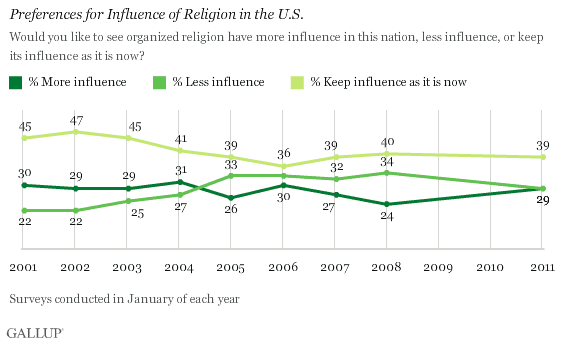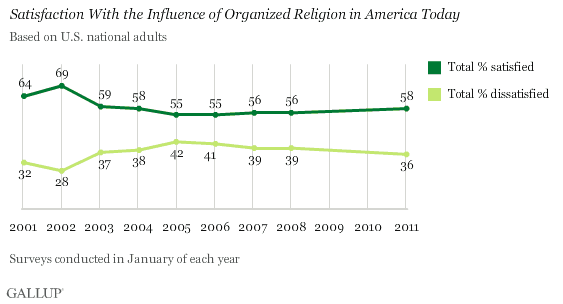PRINCETON, NJ -- Americans have mixed views on the influence of organized religion in the U.S. today, with 29% saying religion should have more influence and an identical percentage saying it should have less influence. A slightly larger 39% believe organized religion's influence should be kept as it is now.

There have been only small changes in these attitudes over the last decade, although from 2001 to 2004, Americans tilted in the direction of more influence rather than less, and from 2005 to 2008, they showed a slight tilt in the opposite direction.
The same Jan. 7-9 Gallup poll finds 58% of Americans satisfied with the influence of organized religion, similar to views in 2003 through 2008, but slightly less than in 2001 and 2002.

Americans are more satisfied with the influence of organized religion than any of the other seven aspects of life in the United States rated in the poll, with the exception of "the overall quality of life," which tops the list.
Of the 36% of Americans who are dissatisfied with the influence of organized religion, most feel that organized religion should have less influence, rather than more.
Attitudes toward the influence of organized religion are strongly related to respondents' level of religious commitment. Americans who attend church at least monthly are more likely to say organized religion should have more influence. Still, slightly less than half of the most religious group -- those who attend church weekly -- want organized religion to have more influence. Most of the rest are content to leave things as they are now. Conversely, slightly less than half of those who seldom or never attend church say organized religion should have less influence.

Religiousness is highly correlated with political orientation in the U.S. today. Republicans are on average significantly more religious than Democrats. This helps explain why Republicans and conservatives are more likely to say organized religion should have more influence, while Democrats and liberals are more in favor of the "less influence" choice.
Implications
The question on organized religion did not specify what was meant by "more influence" or "less influence," leaving open the issue of what respondents may mean when they answer it. Additionally, for some respondents, "organized religion" may connote something different from more informal or personal religion. In general, many Americans today are drifting more toward nondenominational churches and away from identification with formal religion, which means that some may have divergent opinions on the influence of "organized" religion versus a more personal religion.
Still, the results suggest that there is no overwhelming groundswell of opinion in the U.S. today to either quell or expand the influence of organized religion. Opinions on this issue differ by politics, but even among the most religious Americans, less than half say organized religion's influence should be expanded.
Survey Methods
Results for this Gallup poll are based on telephone interviews conducted Jan. 7-9, 2011, with a random sample of 1,018 adults, aged 18 and older, living in the continental U.S., selected using random-digit-dial sampling.
For results based on the total sample of national adults, one can say with 95% confidence that the maximum margin of sampling error is ±4 percentage points.
Interviews are conducted with respondents on landline telephones (for respondents with a landline telephone) and cellular phones (for respondents who are cell phone-only). Each sample includes a minimum quota of 150 cell phone-only respondents and 850 landline respondents, with additional minimum quotas among landline respondents for gender within region. Landline respondents are chosen at random within each household on the basis of which member had the most recent birthday.
Samples are weighted by gender, age, race, education, region, and phone lines. Demographic weighting targets are based on the March 2010 Current Population Survey figures for the aged 18 and older non-institutionalized population living in continental U.S. telephone households. All reported margins of sampling error include the computed design effects for weighting and sample design.
In addition to sampling error, question wording and practical difficulties in conducting surveys can introduce error or bias into the findings of public opinion polls.
View methodology, full question results, and trend data.
For more details on Gallup's polling methodology, visit www.gallup.com.
